Key takeaways:
- Differentiated instruction tailors education to individual student needs, enhancing engagement and fostering a supportive learning environment.
- Key strategies include offering varied learning materials, utilizing multiple forms of assessment, and flexible grouping to cater to diverse learning styles.
- Technology and tools like graphic organizers can significantly aid differentiation, promoting student autonomy and facilitating organizational skills.
- Challenges include the time required for planning differentiated strategies, fairly assessing diverse student progress, and managing classroom dynamics effectively.
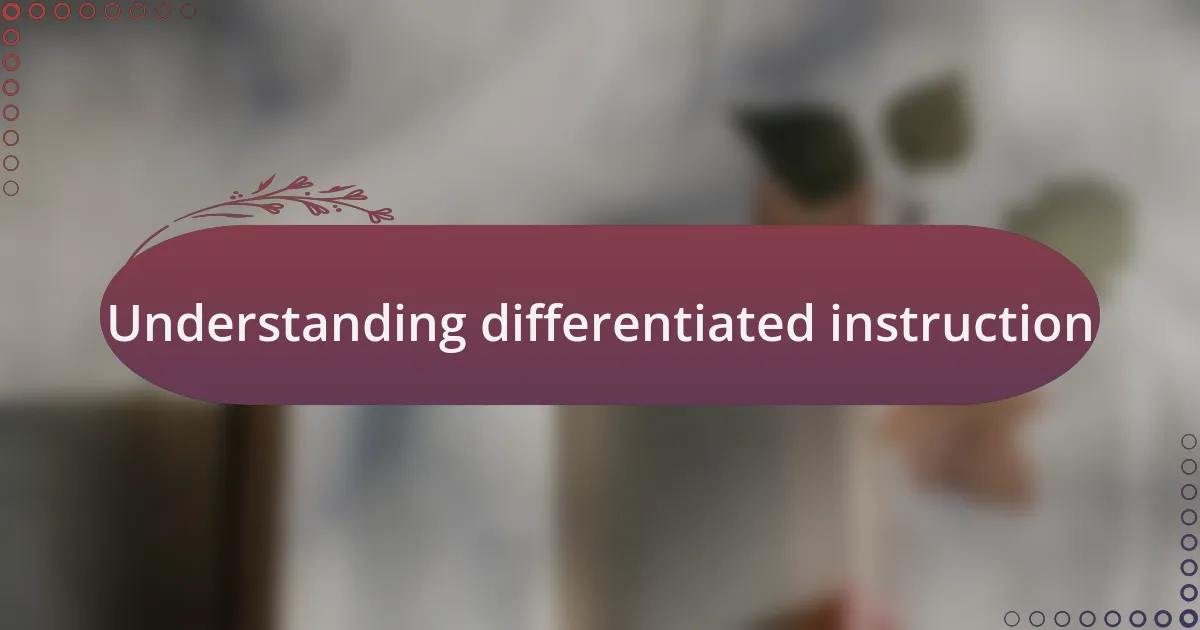
Understanding differentiated instruction
Understanding differentiated instruction means recognizing that every student comes to the classroom with unique strengths, needs, and backgrounds. I remember my early teaching days, when I found it challenging to connect with a diverse group of learners. How could I engage all my students when they were so different? This realization sparked my journey into differentiated instruction.
At its core, differentiated instruction is about tailoring education to meet individual student needs. Some learners thrive with hands-on activities, while others might prefer reading or group discussions. I still vividly recall how one of my students, struggling with traditional methods, flourished when I introduced project-based learning. It was a powerful reminder that the right approach can unlock a student’s potential.
Furthermore, differentiated instruction encourages flexibility, fostering an environment where students feel valued and empowered. Have you ever watched a student’s face light up when they grasp a challenging concept? That joy is what drives me. By adapting lessons to varied learning styles and preferences, I witnessed not just improved academic performance but also a boost in student confidence and enthusiasm for learning.
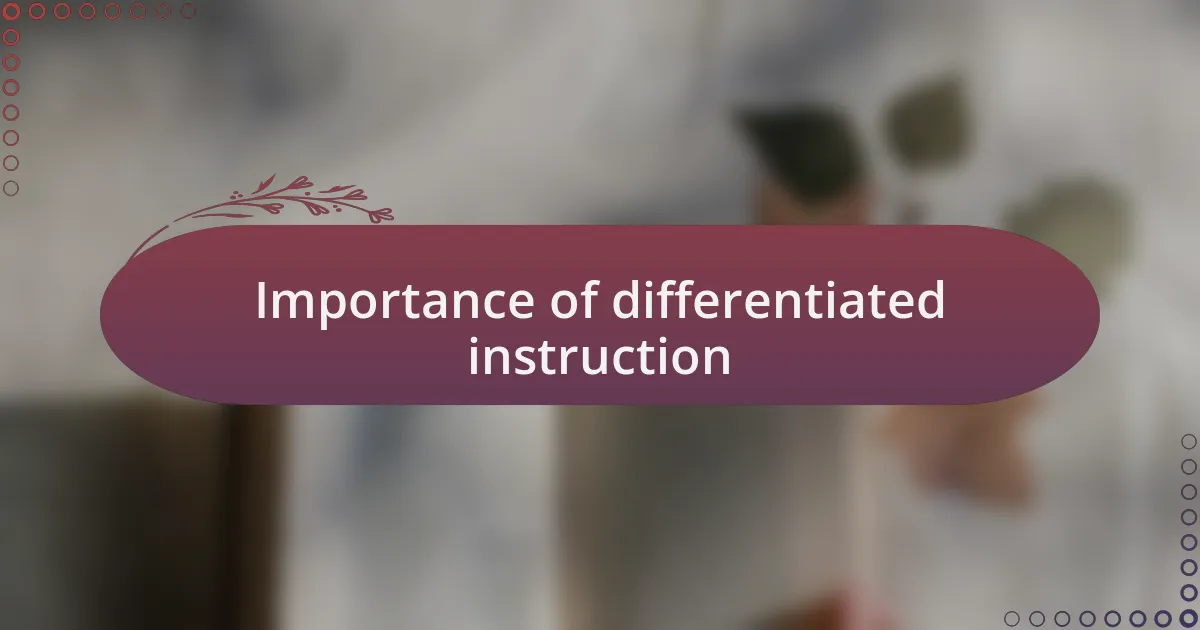
Importance of differentiated instruction
Differentiated instruction holds immense importance in today’s diverse classrooms. I learned this firsthand when I shifted my focus from a one-size-fits-all approach to one that considered students’ unique learning profiles. Suddenly, lessons became more engaging, and I noticed students who once felt overwhelmed were actively participating. Isn’t it incredible how knowing your audience can change the dynamic of learning?
One particularly memorable instance was when I had a group project that required creativity and collaboration. I assigned roles based on individual strengths, allowing students to shine in their own ways. Watching my quieter students take the lead in their areas was a revelation; it reminded me that when we differentiate, we don’t just teach—we inspire. Are you ready to witness the transformative power of tailored instruction in your own classroom?
Moreover, differentiated instruction fosters inclusivity, making learning accessible for everyone. I can still feel the excitement in the room when I introduced flexible grouping strategies, allowing students to choose their peers based on their interests and strengths. This not only enhanced teamwork but also cultivated empathy among students. Have you ever wondered how fostering such an inclusive environment can impact student relationships? It truly helps create a classroom community where each student feels respected and encouraged to grow.
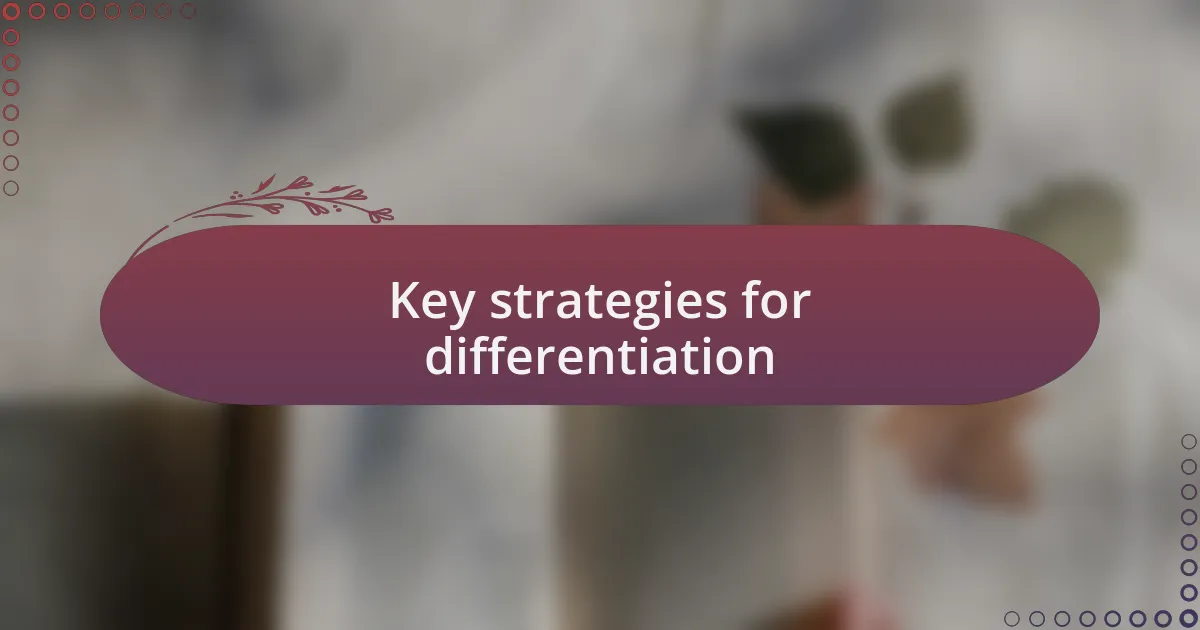
Key strategies for differentiation
When it comes to differentiation, one of the most effective strategies I’ve employed is offering various learning materials tailored to different reading levels. I remember introducing a thematic unit on ecosystems—some students dove into graphic novels, while others engaged with scientific articles. Observing their excitement as they explored the same topic through different lenses was awe-inspiring. Have you ever noticed how choice can ignite a student’s passion for learning?
Another impactful strategy is incorporating multiple forms of assessment. I often design projects that allow students to demonstrate their understanding through visual presentations, written reports, or creative performances. One particular group tackled a history assignment through a skit, bringing to life the events they studied. It was a joy to see a reluctant participant find confidence in performing! Isn’t it fascinating how giving students different pathways to show their knowledge can reveal hidden talents?
Lastly, I’ve found that providing varying levels of support during group work can make a significant difference. During a recent math project, I paired students intentionally, ensuring those who grasped concepts quickly supported their peers. This not only helped struggling learners but also reinforced the understanding of the facilitators. Have you experienced the gratifying moment when students teach each other? It’s a powerful reminder that in a differentiated classroom, collaboration can lead to growth for everyone involved.
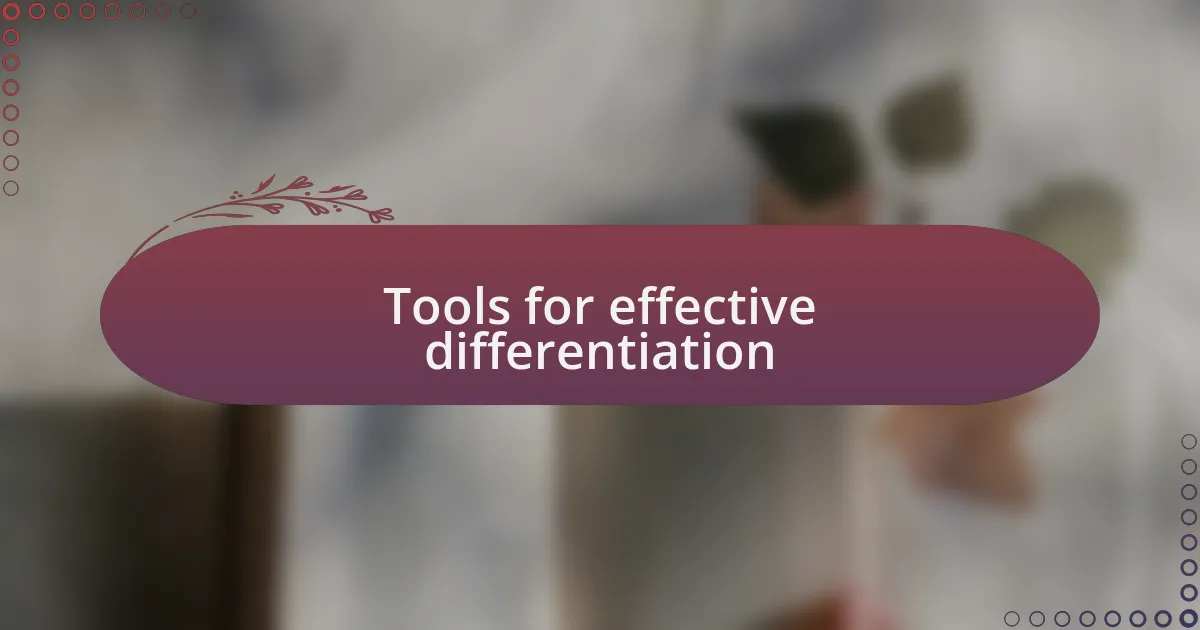
Tools for effective differentiation
One of the most valuable tools I’ve discovered for effective differentiation is the use of technology. Interactive platforms like Kahoot! or Quizizz allow students to engage at their own pace while challenging themselves with tailored quizzes. I remember a time when my students were preparing for a big test; their enthusiasm for competing against each other in a friendly quiz transformed a mundane review session into a fun and dynamic experience. Have you ever seen technology breathe fresh life into content?
Another powerful tool is flexible grouping. I often change student pairs or small groups based on their needs for specific tasks. For instance, during a literature circle, I grouped avid readers with those who needed more guidance, fostering conversations that allowed students to learn from each other. The transformation I witnessed in some quieter students, who suddenly found their voices among peers, was truly touching. Isn’t it remarkable how the right group dynamic can cultivate new confidence?
Lastly, utilizing graphic organizers has been a game-changer in helping students organize their thoughts. When I introduced these tools for a complex writing assignment, many students expressed relief at having a visual aid to brainstorm their ideas. It was rewarding to see how those who previously struggled to outline their thoughts suddenly flourished, crafting coherent essays they felt proud of. How often do we underestimate the impact of a simple organizational tool in unlocking student potential?

My experiences with differentiation
Differentiation has been a transformative aspect of my teaching journey. I recall a particularly challenging math unit where some students grasped concepts quickly, while others struggled. I decided to incorporate hands-on manipulatives for those needing extra support. Watching the lightbulb moments of my students as they solved problems using tangible tools brought me immense joy. Don’t you think seeing that understanding click is one of the best parts of teaching?
Another moment that stands out occurred during a science project. I offered students various options—they could choose to create a presentation, write a report, or even create a model. One student, who typically kept to herself, chose to build a model instead of writing. Her creativity flourished, and she ended up leading the presentation with confidence. It made me wonder: how often do we give students the chance to showcase their strengths in ways that resonate with them?
One of my most rewarding experiences with differentiation happened during a novel study. I allowed students to choose their books based on their interests and reading levels, which ignited a new passion for reading in many. I still remember how one student, who usually struggled with engagement, was completely absorbed in her chosen story. Did you ever think that giving students ownership over their learning could lead to such profound engagement? It has certainly changed my perspective on how we approach reading in the classroom.
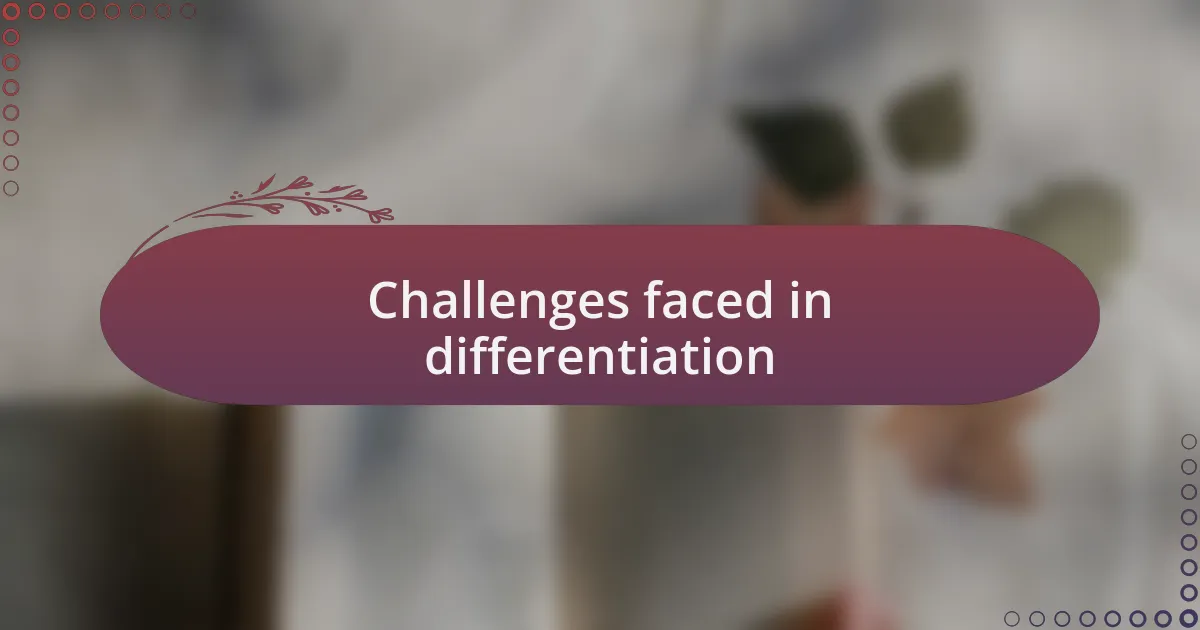
Challenges faced in differentiation
In my journey with differentiated instruction, one significant challenge I’ve encountered is the time it takes to plan and implement diverse strategies for each student’s needs. There were times when I found myself overwhelmed, trying to cater to varying learning styles while balancing the curriculum requirements. How do we reconcile the need for individualized attention with the ticking clock of a school day? This constant balancing act can create pressure, sometimes leaving me questioning whether I was truly meeting every student’s potential.
Another obstacle I’ve faced is assessing student progress fairly. It’s tricky to measure comprehension when students are working at different levels. I often recall a unit where I had students working on different assignments related to the same topic. I ended up with various forms of assessments ranging from traditional tests to creative projects. But then, how do I quantify those results in a way that reflects each student’s understanding accurately? This lack of a uniform assessment method sometimes left me feeling uncertain about my effectiveness as a teacher.
Furthermore, classroom management often becomes more complex when differentiating instruction. I remember a time when I focused on group work tailored to various skill levels, which led to a ruckus as students engaged in lively discussions. While that energy can be astonishing, it also demands a tighter rein. How do we encourage that enthusiasm while maintaining a productive learning environment? This was yet another layering of challenge, but I discovered that clear expectations and structured timing could help steer that energy into meaningful collaboration.
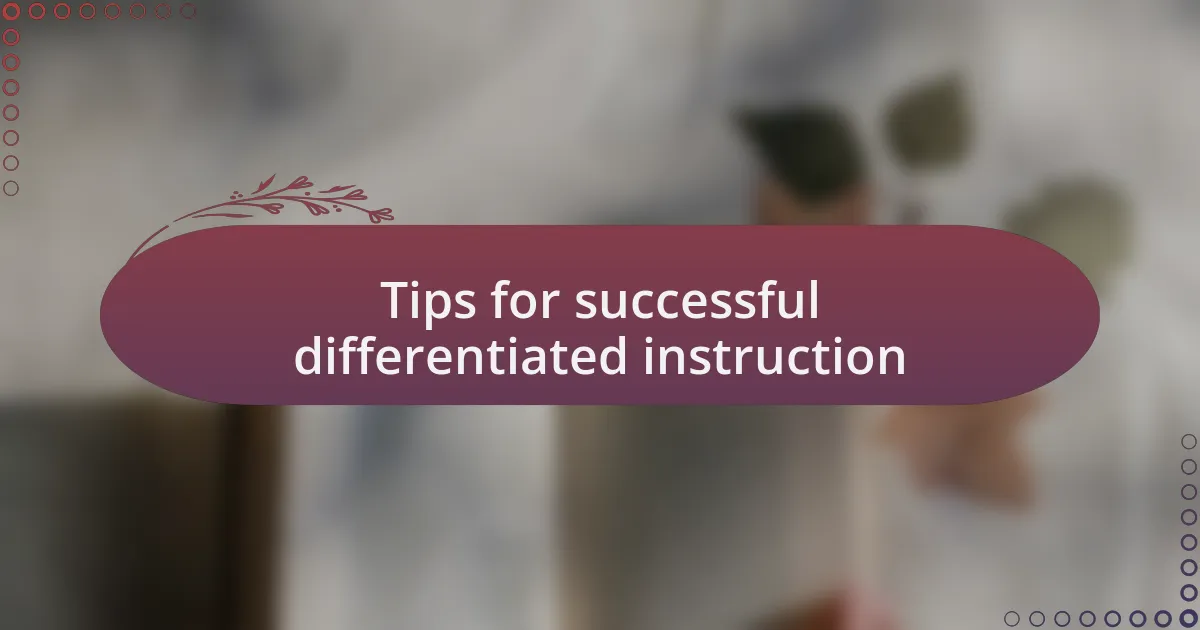
Tips for successful differentiated instruction
When I think about successful differentiated instruction, one of the pivotal tips is to know your students deeply. I once took the time to create student profiles, which included their interests, strengths, and areas where they struggled. This approach not only informed my lesson planning but also built stronger connections with my students. Have you ever paused to consider how much a single conversation can reveal about a learner’s passion?
Another essential strategy is to use flexible grouping. I vividly recall a situation where I grouped students for a project based on their strengths. Those initial discussions laid bare the students’ diverse talents and offered them a chance to shine in ways I hadn’t anticipated. This dynamic arrangement transformed the classroom; energy surged, collaboration blossomed, and even the shyest students found their voices. Isn’t it remarkable how a simple shift in grouping can drastically change classroom dynamics?
Technology can also be a game-changer for differentiation. I remember introducing educational apps that adapted to each student’s learning level. Some students raced ahead, while others benefitted from guided practice—each progressing at their own pace. This blend of technology with traditional methods allowed me to meet students where they were, making learning personalized and engaging. Have you ever wished for tools that could scale your instruction without overwhelming you? Embracing these digital resources did just that for me, and it opened doors for my learners.